Cloud Video Hosting: What Professional Broadcasters Need to Know in 2025
Each year, more enterprises are migrating their digital infrastructure to the cloud, and video is no exception. As video content becomes increasingly vital for communication, engagement, and monetization, shifting video hosting and streaming to the cloud is a strategic move. With demand for high-quality, on-demand, and live video content at an all-time high, broadcasters are under increasing pressure to deliver seamless viewing experiences across devices and geographies.
Traditional, on-premise infrastructure simply can’t keep up with the need for scalability, speed, and global reach. That’s why leading media companies, streaming services, and enterprise broadcasters are embracing cloud video hosting platforms. They use them to manage, store, transcode, and distribute video content more efficiently than ever.
Modern cloud-based video platforms offer more than just storage. They provide real-time analytics, AI-powered content indexing, automated transcoding, and built-in CDN support for global delivery. As viewers expect 4K streams, ultra-low latency, and personalized experiences, broadcasters need robust, secure, and scalable solutions.
Cloud video hosting isn’t just a technical upgrade but a strategic shift that impacts monetization, content security, and viewer retention. For broadcasters, staying ahead means understanding the architecture, capabilities, and competitive advantages of today’s leading platforms.
Table of Contents:
- How Streaming Servers Power Cloud Video Hosting
- What Is Cloud Video Streaming?
- Key Features of a Cloud Video Hosting Platform
- Top 12 Cloud Video Hosting Platforms
- Cloud Video Hosting Novelties in 2025
- AI Trends in Cloud Hosting
- How to Choose the Right Cloud Video Host
- FAQs
- Conclusion
How Streaming Servers Power Cloud Video Hosting
At the core of every cloud video streaming platform are powerful streaming and hosting servers. These servers are specialized computers designed to receive, store, process, and deliver video content to viewers anywhere in the world.
For live streaming, video is first captured by cameras and sent to an encoder. The encoder transmits the stream to the server using RTMP (Real-Time Messaging Protocol). The server ingests the live stream and often transcodes it into formats like HLS, which are more efficient for delivery to different devices.
For on-demand video, broadcasters upload files to the server using HTTP. The server stores the files and prepares them for playback in various resolutions and formats. This makes it possible to support adaptive bitrate streaming, which ensures smooth viewing even on slow networks.
Tasks like ingesting, transcoding, and distributing video require significant storage and processing power. That’s why large-scale deployments use clusters of servers across multiple data centers.
A modern secure cloud-based video delivery system relies on these servers to ensure fast, reliable, and protected access to content. This infrastructure allows broadcasters to scale globally, reduce latency, and maintain high performance for both live and on-demand content.
What Is Cloud Video Streaming?

Cloud video streaming uses a global network of servers to deliver video over the internet. Instead of managing on-premise infrastructure, broadcasters rely on a cloud-based video platform to handle storage, processing, and delivery.
This approach eliminates the need for expensive hardware and dedicated IT teams. It also simplifies workflows, allowing broadcasters to focus on content creation rather than technical upkeep. As audiences grow, cloud platforms allow fast, seamless scaling. And when traffic drops, broadcasters aren’t stuck paying for idle resources.
Cloud streaming also handles video transcoding. Cameras often capture large RAW files that aren’t suitable for web delivery. Cloud platforms automatically convert these files into formats that work on all devices.
By supporting multiple output formats, cloud streaming enables adaptive bitrate video hosting solutions. This ensures smooth playback for users on any connection, from mobile networks to fiber.
With cloud streaming, broadcasters gain flexibility, efficiency, and global reach, all without the burden of managing physical servers.
Key Features of a Cloud Video Hosting Platform
Before we look at some of the best cloud video hosting options to choose from, let’s cover some essential features for broadcasters.
1. Video Monetization
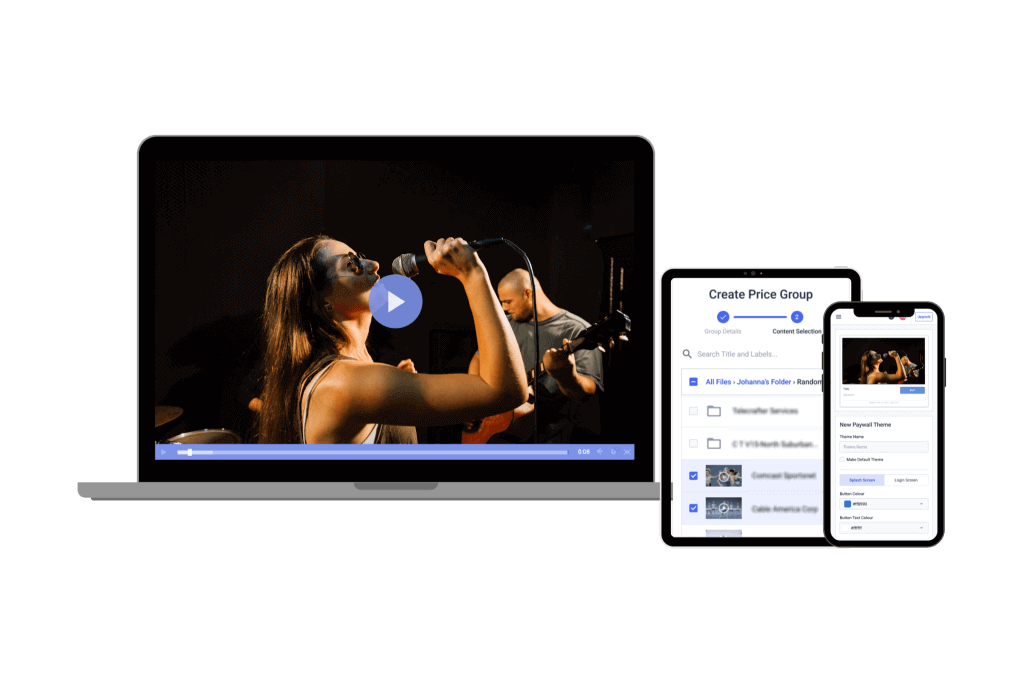
Most broadcasters want to generate revenue from their video content, which is why their cloud video hosting platform has easy-to-use video monetization capabilities. Brands should be able to set up subscriptions, ad-based video monetization, and pay-per-view options. A built‑in paywall must support global currencies and taxes while safeguarding transactions.
2. Video Content Management System (CMS)
A cloud video hosting platform with video CMS features allows broadcasters to better organize and manage their videos. Tag, sort, and search a growing library with ease. Advanced CMS engines can mine metadata to surface related clips and boost watch time automatically.
3. Developer Tooling and APIs
A rich video API for custom video integrations is essential. Look for REST or GraphQL endpoints, language‑specific SDKs, CLI utilities, GitHub samples, and webhook triggers that let engineers automate every workflow—upload, encode, publish, and analyze.
4. Direct S3/FTP Upload
There shouldn’t be any friction for adding content to a cloud video hosting platform. That’s why broadcasters need the ability to upload large files directly via FTP/S3 to the cloud host without the limitations of HTTP transfer.
5. Mobile Video Streaming & Hosting
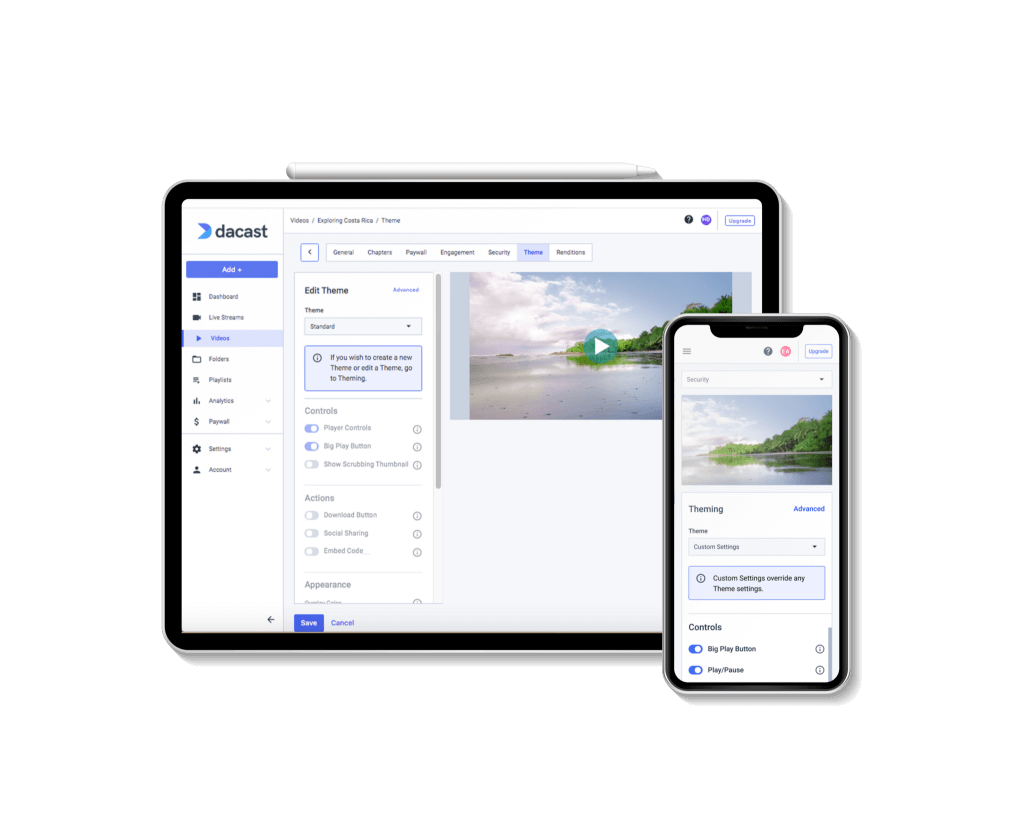
HLS delivery to an HTML5 player ensures smooth viewing on iOS, Android, and progressive web apps. Responsive UI skins and gesture controls further elevate the experience.
6. Chapter Markers
Segment long‑form video by topic or timestamp so viewers can jump to the content that matters most. A cloud video hosting platform with chapter markers and other advanced playback features can help brands and their audiences get the most out of their video content.
7. Video on Demand (VOD)
Many broadcasters and businesses offer both live streaming and Video on demand (VOD) content. This requires a professional business video hosting platform to upload any source format, transcode for storage, and publish instantly to web, mobile, and OTT endpoints.
8. Content Delivery Network (CDN)
While a cloud platform may be scalable, the performance end-users’ experience often depends on the location of the servers geographically. A global edge CDN network reduces latency, cuts buffering, and preserves quality for viewers on every continent.
9. Live Recording
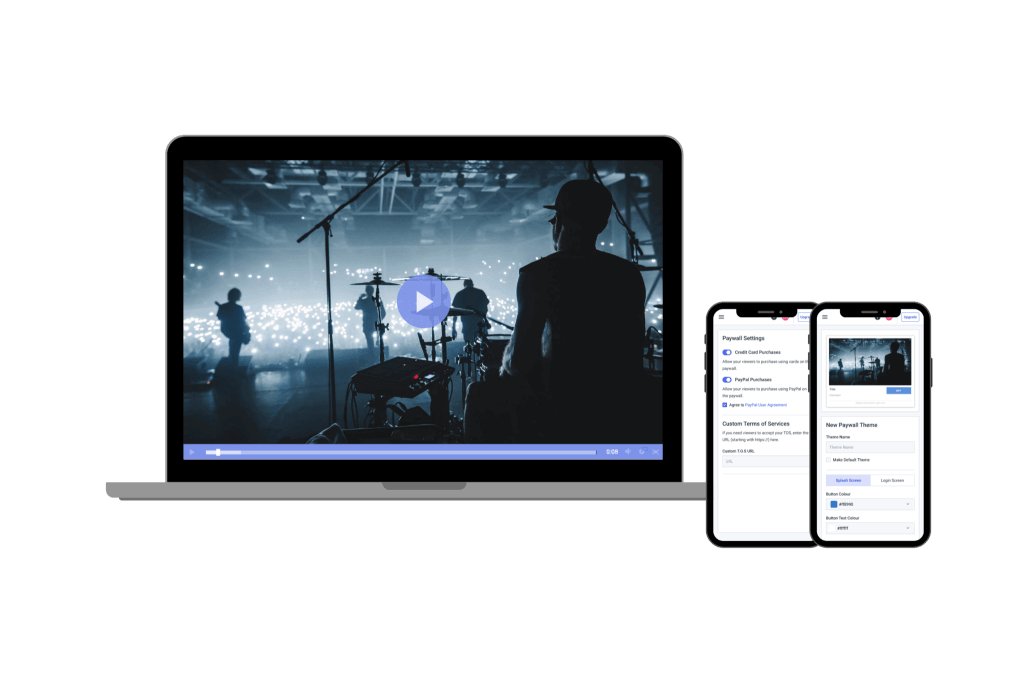
Along with uploading video content, broadcasters that host live events should be able to record live streams for playback later. The cloud video host platform should capture live streams in the cloud, then auto‑archive them as VOD assets to maximize replay value and long‑tail monetization.
10. Playlist Schedulers
While many viewers are cutting the cord and shifting towards online broadcasters, many still value the TV viewing experience. Build 24/7 linear channels by pre‑programming live streams, VOD assets, and ad breaks—no traditional playout hardware required.
11. Security
Broadcasters should have confidence that their cloud video platform follows security standards and privacy regulations. That way, they won’t lose valuable video content due to piracy, hacking, or another disaster. An enterprise-grade platform should include password protection, domain restrictions, encryption, and other advanced security measures.
12. Pricing Flexibility
The subscription costs and live streaming pricing for a cloud video platform can vary depending on traffic, storage requirements, and many other factors. It’s crucial that broadcasters choose a platform that offers the features they need at a reasonable price while providing room for growth in the near term as well.
13. Trust and Compliance
The platform must meet GDPR, SOC 2, and region‑specific rules such as China’s Great Firewall. Features like geo‑blocking, audit logs, and encryption at rest enable secure cloud‑based video delivery that satisfies corporate governance teams.
14. Scalable Transcoding and ABR
Cloud resources convert source files into multiple renditions, enabling adaptive bitrate streaming that adjusts quality in real time to each viewer’s bandwidth.
Top 12 Cloud Video Hosting Platforms
We’ll discuss the top 12 cloud video hosting platforms in more detail, but first, here is a brief overview of what they have to offer.
| Platform | Upload Specs | Max Res. | Formats | Pricing (from) | Key Features | Support | Uptime / Latency |
|---|---|---|---|---|---|---|---|
| Dacast | FTP/S3, RTMP ingest | Up to 4K | MP4, MOV, MKV, AVI, FLV, + | $39/mo | Live & VOD, monetization, ABR, SDKs, China CDN, AES | 24/7 live chat & email | ~99.9%; ~10 s latency |
| Brightcove | HTTP/FTP | 1080p/4K | MP4, MOV, HLS, DASH | ~$200+/mo | Analytics, marketing tools, global CDN | Business hours + SLA tiers | ~99.5%; ~10–20 s latency |
| IBM Video Cloud | HTTP | 1080p | MP4, HLS, DASH | Custom | AI insights, CMS, pay-per-view | SLA with IBM support | ~99.7% |
| Kaltura | HTTP/S3 | 4K | MP4, MOV, DASH | Starts ~€1000/mo | VPaaS, custom workflows, enterprise features | Enterprise support | ~99.8% |
| Wistia | HTTP | 1080p | MP4 | $99/mo | Marketing tools, CTAs, analytics | Email support | ~99.9% |
| Vidyard | HTTP | 1080p | MP4 | $150+/mo | Sales tools, analytics, sharing | Email & phone (tiers) | ~99.9% |
| Dailymotion | HTTP upload | 1080p | MP4 | Free | Consumer, ad revenue share | Online help | ~99% |
| JWPlayer | HTTP | 4K | MP4, HLS, DASH | $50/mo | Player, ads, CDN | Email & chat | ~99.9% |
| Wowza | RTMP/HTTP | 4K | MP4, HLS, WebRTC | $149 or $130/mo | Low-latency WebRTC, DRM | 24/7 support tiers | ~1 s latency; ~99.9% |
| Panopto | HTTP | 1080p | MP4, MOV | Custom | Education, search, LMS | Institutional support | ~99.9% |
| SproutVideo | HTTP | 1080p | MP4 | $49/mo | Privacy, analytics, CMS | Email support | ~99.9% |
| Vimeo | HTTP/S3 | 4K | MP4, HLS | $65/mo | Live & VOD, OTT, AI subtitles | 24/7 support (Pro+) | ~99.9% |
1. Dacast
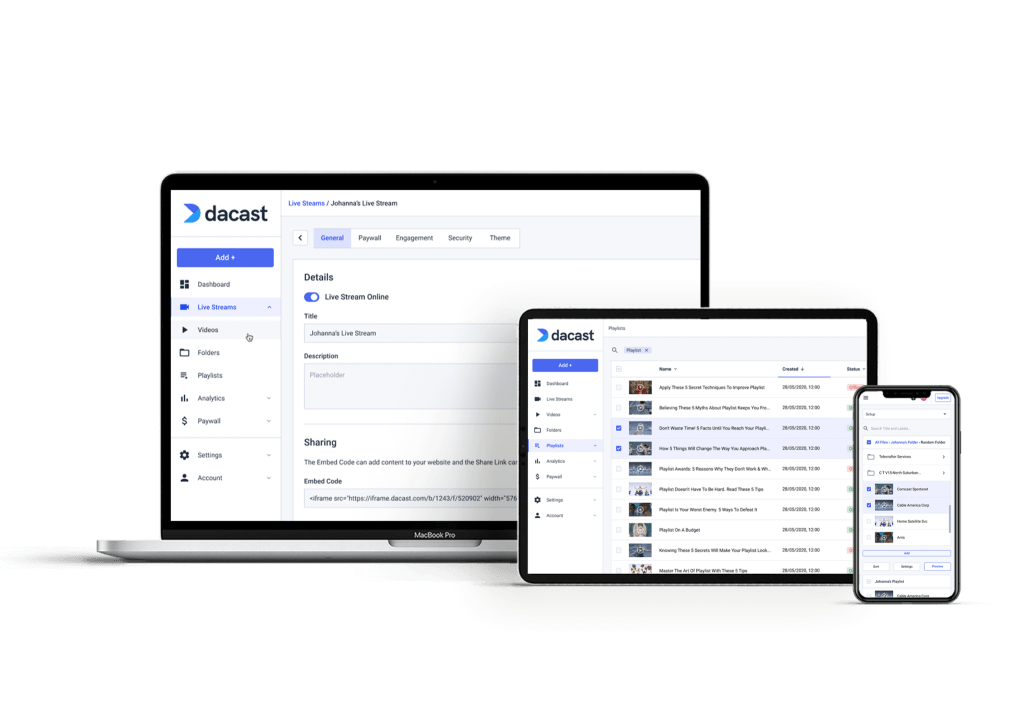
Company Background:
Dacast is a cloud-based video hosting and streaming platform founded in 2008. It offers enterprise-grade live and VOD capabilities tailored to small and mid-sized businesses seeking professional features without high infrastructure costs.
The platform supports scalable video delivery, including pay-per-view pricing, advanced analytics, cloud-based transcoding, and secure storage. Users can easily manage, monetize, and repurpose live streams as on-demand content, all through a streamlined, cost-effective solution.
Key Features:
- Monetization tools (SVOD, AVOD), and pay-per-view (TVOD)
- White label and branding control
- Adaptive bitrate streaming to allow multiple streams with varying bitrates
- RTMP Encoder for ingesting HLS streaming
- Low latency HTML5 channels for video streaming
- Live encoding support for the top video encoders
- Zoom live streaming integration
- Expo galleries video portal
- Unlimited viewers and live channels
- Video security tools for secure streaming
- Global content delivery with strategic CDN partnerships
- Multi-bitrate streaming
- Player API and Video API access
- 24/7 tech support
- M3U8 file creation capability to enable adaptive streaming delivery of OTT video content across various devices
- Multistreaming capabilities for simulcasting to multiple platforms at once
- Fully integrated RTMP streaming platform features
- AES encryption for secure video streaming
- Multi-user access on Scale and Custom plans
- Zoom live streaming integration for meetings and live events in real-time
| Pros | Cons |
|---|---|
|
|
Pricing:
Dacast has pricing plans which include:
- Starter Plan: $39/month (includes 2.4 TB of bandwidth & 500 GB of storage)
- Event Plan: $63/month (includes 6 TB of bandwidth upfront and 250 GB of storage)
- Scale Plan: $165/month (includes 24 TB of bandwidth per year and 2000 GB of storage)
- Custom plan: Contact us for custom pricing plans
Best Use Cases:
- Online Video Hosting for SMB and Enterprise
- Solutions for Government and Municipality
- Education and E-Learning Streaming Solution
- Enterprise Cloud Video Platform
2. Brightcove

Company Background:
Founded in 2004, Brightcove is a pioneer in cloud video. The company delivers an enterprise video hosting suite focused on marketing, monetization, and cross‑channel distribution. Its global cloud infrastructure, backed by built‑in CDN support, lets organizations stream to viewers in North America, Europe, and Asia‑Pacific with secure cloud‑based video delivery.
Key capabilities include:
- Scalable live and VOD streaming in one unified console
- Native integrations with CRM, marketing automation, and ad‑tech platforms
- Monetization options (SVOD, AVOD, TVOD) and detailed audience analytics
- Robust APIs and SDKs for custom workflows and app embeds
Brightcove’s feature set allows brands to create, manage, and publish high‑quality video across any device while tying engagement data directly into existing business systems.
Key Features:
- Enterprise-grade cloud video hosting platform
- Video CMS Platform
- Marketing and monetization tools
- Advanced video API for custom video integration
- Customizable video player
- Secure cloud-based video delivery
- Global CDN and adaptive bitrate streaming
- Multi-language and multi-region support
- AI-powered cloud video platform features
- Third-party integrations
- Over-the-top (OTT) streaming
| Pros | Cons |
|---|---|
|
|
Pricing:
Brightcove offers custom pricing plans tailored to the needs of enterprise users. Businesses must contact Brightcove’s sales team directly to get an accurate quote, particularly for live streaming capabilities.
Here’s what’s currently known about Brightcove’s pricing structure:
- Basic Plan – Starting at $99/user/month
Includes core video hosting and management features. Ideal for businesses with smaller content libraries or internal communications needs.
- Enterprise Plans – Custom pricing
These plans offer advanced features such as live streaming, detailed analytics, enterprise-grade security, and integration with third-party platforms. Pricing depends on factors like audience size, storage volume, monetization tools, and support requirements.
- Additional Customization Costs
Enterprises may incur extra fees for platform customization, onboarding, training, data migration, or dedicated support. These costs can range from several thousand dollars, depending on project scope and complexity.
- Free Trial Available
Brightcove provides a free trial, allowing organizations to evaluate the platform’s features and performance before committing.
Best Use Cases:
- Global enterprise communications
- Enterprise marketing campaigns
- Monetized video platforms
- Broadcaster-grade live streams
- Video-first SaaS and digital products
3. IBM Video Cloud

Company Background:
IBM Cloud Video is an enterprise-grade cloud video hosting platform designed for large-scale live streaming and VOD. Launched in its current form after IBM acquired Ustream in 2016 and merged it with Cleversafe, Clearleap, and Aspera, the platform serves sectors such as media and entertainment, education, corporate training, and virtual events.
This cloud-based video platform offers scalable, secure streaming solutions backed by IBM’s infrastructure and AI-powered analytics tools. Organizations benefit from real-time insights, performance optimization, and support for large global audiences with minimal latency.
It’s a platform that supports both live streaming and VOD delivery with cloud infrastructure that can handle high viewer volumes without lag or interruption. It also includes tools for managing multiple simultaneous streams, making it a solid choice for large-scale virtual conferences or enterprise broadcasts.
Key Features:
- Built-in content delivery network (CDN) for scalable video distribution
- OTT video management capabilities
- Video monetization tools for revenue generation
- Workflow automation for video publishing and management
- Live and on-demand video streaming
- Secure content sharing with enterprise-grade access controls
| Pros | Cons |
|---|---|
|
|
Pricing:
The pricing plans for the IBM Cloud Video include:
- Start Trial – Video Streaming: Give it a free test drive for 30 days
- Silver: Affordable Essentials, 100 viewer hours, 5 channels, 1 TB video storage, starting at $145/month
- Gold: Standard business features, 2,000 viewer hours, 10 channels, 2 TB video storage, starting at $729/month
- Platinum: Premium Volume scale, 5,000 viewer hours, 20 channels, 5 TB video storage, starting at $1,460/month
- Custom: Please contact IBM Cloud video for custom plan pricing as well as payment plans
IBM Video Streaming also offers an SaaS streaming service with AI-driven deep search for security-rich video communications. Here are the IBM Enterprise Video Streaming pricing plans:
- Enterprise Silver: $847/month
- Enterprise Gold: $2,120/month
- Enterprise Platinum: $5,300/month
- Custom: Contact the sales team
30-day free trials are available for test-driving both the IBM Video Streaming and the IBM Enterprise Video Streaming services.
Best Use Cases:
- Cloud video hosting for marketing and enterprises
- Virtual conference streaming
- Media & entertainment video management
4. Kaltura
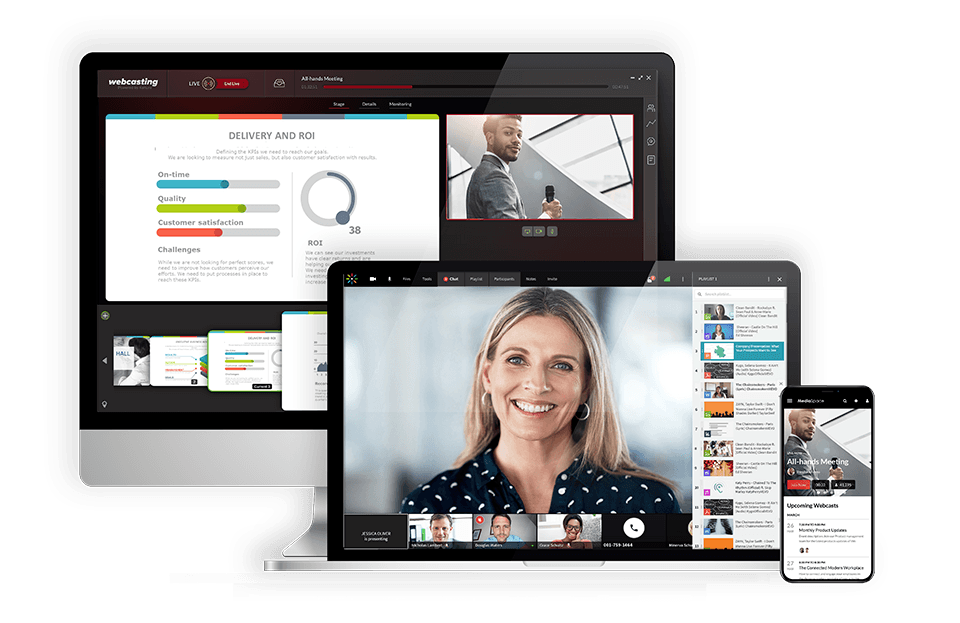
Company Background:
Founded in 2006, Kaltura is an Israeli-based SaaS company offering a flexible cloud video hosting platform tailored for enterprises and educational institutions. With a strong emphasis on customization and open-source architecture, Kaltura powers a wide range of video solutions—from virtual classrooms to OTT services—for clients around the globe.
Widely adopted in the EdTech and corporate sectors, Kaltura supports both live streaming and video on demand (VOD). It integrates easily with platforms like Canvas LMS and PowerPoint, enabling seamless transitions between webcam and content. The platform also features in-video quizzing, allowing interactive learning experiences, and advanced categorization tools to organize streams into chapters or albums post-broadcast.
Its scalability, deep feature set, and secure cloud-based video delivery make it one of the best cloud video hosting solutions for 2025, especially for organizations that need robust video infrastructure with flexible deployment options.
Key Features:
- Live and VOD streaming
- LMS Integration
- In-video quizzing
- Transcoding and multi-device playback
- Video CMS
- Open-source and API access
- Secure cloud-based delivery
- Analytics dashboard
- OTT and monetization tools
- Collaboration tools
| Pros | Cons |
|---|---|
|
|
Pricing:
Kaltura’s pricing is tailored to large enterprises and educational institutions that require fully customizable video solutions. Pricing varies based on the specific services and scale of use. Here’s a breakdown of available plans:
- Business: $199/month (or $150/month when billed annually)
- Enterprise: Custom pricing
- Basic: $19/month (or $17/month when billed annually); up to 8 participants per session and 8 hrs of cloud recording
- Pro: $55/month (or $50/month when billed annually); up to 25 participants per session and 15 hrs of cloud recording
- Business: $125/month (or $115/month when billed annually); up to 100 participants per session and up to 25 hrs of cloud recording
- Business Plus: Custom pricing for up to 300 participants per session, unlimited sessions and custom storage needs
- Annual discounts: Discounted pricing packages available for any scale and use-case, enterprise SLA, and developer support
- Limited trial account: $1 for $100 worth of credits for 30 days for testing and experimentation, with no commitments
- Pay as you go – Base plan ($20/year) + monthly usage fees based on consumption
- Base plan: $20 one-time annual fee + monthly usage fees
Kaltura also supports meetings, virtual events, town halls, video messaging, and video portals. Custom bundles and mix-and-match solutions are available by contacting the sales team.
Best Use Cases:
- Higher education and academic institutions
- Enterprise training and corporate learning
- Virtual events and webinars
- Media and OTT video services
- Government and public sector
- Health and telemedicine (with custom compliance setups)
5. Wistia

Company Background:
Wistia is a cloud video hosting platform tailored for businesses and educators, originally created by students to serve institutional and professional video needs. With over a decade in the video hosting industry, Wistia focuses on providing user-friendly tools for video creation, management, and streaming.
Its intuitive interface and strong branding features make it ideal for companies looking to embed secure cloud-based video delivery into their marketing, sales, or training workflows. Wistia supports high-quality playback, detailed viewer analytics, and seamless integration with major CRM and marketing platforms, making it a top choice among the best cloud video hosting solutions 2025.
Key Features:
- Video API access
- Support for marketing (SEO and engagement stimulators)
- Fully customizable HTML5 player
- Top-tier customer service
- CRM integrations for a streamlined broadcasting experience
- Multi-bitrate and adaptive streaming
- Security features
- Powerful video analytics
| Pros | Cons |
|---|---|
|
|
Pricing:
Wistia has five pricing plan tiers, with a 20% discount when billed annually:
- Free: No cost to use; up to 250 subscribers and 3 videos; cannot remove Wistia’s branding from the video player; 15 minutes maximum webcam recording time
- Plus: $19/month; 30 minutes maximum webcam recording time; video SEO; option to remove Wisita branding; $2.00 for extra media costs
- Pro: $79/month; 60 minutes maximum webcam recording time; supports up to five channels; $1.00 for extra media costs; Google analytics integration; white-label video player
- Advanced: $319/month; supports unlimited number of channels; A/B testing features; live chat and priority support; $0.50 for extra media costs; 60 minutes screen and webcam recording time
- Enterprise: there are also business solutions with custom pricing; supports an unlimited number of users; 60 minutes screen and webcam recording time; $0.25 for extra media costs; custom pricing for live event additional costs
Best Use Cases:
- Small to medium business
- Marketing and brand promotion
- Product demos and explainer videos
- Education content
- Customer support and training
6. Vidyard

Company Background:
Founded in 2010, Vidyard is a cloud video streaming platform initially focused on video marketing. However, it has since evolved into a comprehensive solution for hosting and delivering professional video content.
It primarily serves marketing, sales, and corporate communications teams, helping businesses engage audiences and drive conversions through video. With an intuitive interface and advanced video analytics, Vidyard integrates seamlessly with popular CRM and marketing automation tools like HubSpot.
Vidyard is a powerful cloud video hosting platform designed to convert viewers into loyal customers. Its interactive features support personalized content through dynamic video messaging, embedded CTAs, and in-video forms, enhancing engagement and lead generation.
Key Features:
- Cloud integrations
- Video hosting and streaming
- Secure cloud video platform
- Interactive viewing experiences
- Video SEO
- Personalization, playlist, and other viewing features
- Advanced video analytics
- Robust security options
| Pros | Cons |
|---|---|
|
|
Pricing:
Vidyard prices its platform based on the use case and includes the following packages:
Pricing packages for Individuals and Teams:
- Free: $0/month; limited video recording, up to 30 minutes video recording length
- Plus: $59/month, billed annually; Unlimited video recording, hosting, and recording lengths
- Teams: $99/month, everything in Starter + CRM/MAP integrations for seamless workflows, folder management, video captions, and advanced analytics
- Enterprise: Custom pricing, with add-ons available
Best Use Cases:
- Video hosting and streaming for marketing
- Enterprise hosting and streaming solutions
- Video streaming for sales
7. DailyMotion

Company Background:
Founded in 2005, DailyMotion is a consumer-focused streaming platform offering basic on-demand video hosting alongside professional features for developers and advanced broadcasters. Often regarded as the French alternative to YouTube, DailyMotion stands out with fewer content restrictions. This is what makes it attractive to a wide range of creators, from independent producers to large enterprises. It boasts a robust content delivery infrastructure and flexible monetization and video management options.
DailyMotion makes managing and sharing on-demand and live-stream video straightforward with cloud video hosting and unlimited streaming bandwidth and storage for partners. This makes it an excellent choice for users with extensive video libraries or frequent live events, supporting a seamless cloud-based video delivery experience.
Key Features:
- Infrastructure for video streaming
- Consumer-grade platform with some professional capabilities
- Specialized tools for developers and partners
- Integrates with many gaming platforms
- Localized to 35 countries and 18 languages
- Offers closed captions and privacy options to limit access to your videos
| Pros | Cons |
|---|---|
|
|
Pricing:
Dailymotion offers a free version for both viewers and content creators, but this comes with the option to monetize videos through ads. While there is a free version, Dailymotion also provides paid subscription options for users and partners who want to remove ads and access additional features.
Dailymotion offers the following three paid subscription plans under its “Dailymotion Pro” to cater to different needs, from basic content management and distribution to more advanced features and customization options:
- Trial plan: Designed for smaller businesses with basic content management and distribution needs. It offers 25K plays, 50GB storage, 100GB bandwidth, and 40 hrs encoding.
- Business plan: Suitable for businesses requiring more advanced hosting features and customization. It includes 1M plays, 1TB storage, 2TB bandwidth, and 200 hours of encoding.
- Enterprise plan: Tailored to meet the specific needs of larger businesses or those with complex video hosting, delivery, and advertising requirements. It’s a fully customizable plan.
Best Use Cases:
- The latest news for consumers and businesses
- Live streaming for entertainment and media
- Video on demand for sports broadcasting
8. JWPlayer

Company Background:
Founded in 2005, JW Player began as a pioneer in HTML5 video playback and played a key role in powering early versions of YouTube. Today, it has evolved into a robust cloud video hosting platform designed for both live and on-demand video streaming.
JW Player offers a full-featured cloud video streaming platform that caters to businesses of all sizes. It provides customizable video players, in-depth analytics, monetization tools, and broad integration with smart devices and streaming protocols.
Users can easily upload, organize, and manage content while delivering secure cloud-based video delivery across multiple channels.
Key Features:
- Video API access with all plans
- Live streaming and VOD hosting
- Delivering global content
- Basic security features
- Analytics tools and revenue tracking
- Custom “watch next” recommendations
- Multi-bitrate and adaptive streaming
- Use of advertising for monetization
| Pros | Cons |
|---|---|
|
|
Pricing:
The JW Player pricing structure is based on custom needs. Contact their sales team to discuss your requirements and get a bespoke price. You can choose between the following plans:
- Stream: This plan offers video delivery, asset management, instant, and broadcast live
- Play: This plan offers cloud hosting, HTML5 Player, OTT apps, and mobile SDKs
- Engage: Take advantage of real-time analytics, recommendations, article matching, and custom reports
- Monetize: Use tools like ad insertion, player bidding, outstream ads, and studio DRM
Best Use Cases:
- Media and publishing
- Marketing and brand storytelling
- Live event streaming
- Video hosting for business websites
- Ad-supported video platforms
- OTT and mobile video apps
9. Wowza

Company Background:
Founded in 2005 by David Stubenvoll and Charlie Good, Wowza is a bootstrapped company that provides reliable live and on-demand streaming solutions across mobile devices, tablets, consoles, and more. The platform emphasizes accessibility, flexibility, and cost-effectiveness, making it a strong choice for organizations seeking scalable video delivery.
Wowza offers two main products:
- Wowza Streaming Engine: A widely adopted self-hosted media server used for customizable, on-premise streaming deployments.
- Wowza Streaming Cloud: A fully managed, cloud-based solution designed for low-latency global delivery. It supports live and VOD streaming to audiences of any size, with robust features for encoding, transcoding, and adaptive bitrate delivery.
Key Features:
- Cloud transcoding
- Support for live streaming and VOD
- White-label video player
- All-device streaming with an HTML5 video player
- API access available
- Reliable customer support
| Pros | Cons |
|---|---|
|
|
Pricing:
- Pay As You Go: $0 per month only pay for usage at a rate of $2.50 per streaming hour and $0.10 per viewer hour
- One Month of Streaming: $149 one-time purchase; includes 15 hours of live streaming and 500 viewing hours
- Plans built for your needs: Best for large audiences and large volume videos, but you should contact Wowza for custom pricing
All the Live Event plans reflect rates when paid monthly and include full brand control, multi-bitrate streaming, and UHD and HD streaming.
The Wowza Streaming Engine has its own professional-grade streaming plans billed annually and includes:
- Basic Monthly: $195/month with the first instance included (Additional instances $195)
- One Month Streaming: $295/month with the first instance included (Additional instances $295)
- Enterprise: Please contact Wowza directly for access to their custom-tailored high volume enterprise solutions
Best Use Cases:
- Live event streaming
- Interactive streaming
- Low-latency streaming
- VOD hosting
10. Panopto

Company Background:
Starting in 2007, Panopto is a cloud video hosting platform designed primarily for businesses and academic institutions. With over 5 million users worldwide, it specializes in secure cloud-based video delivery for internal communication, training, and education. Its standout feature is deep integration with popular learning management systems (LMSs), making it especially valuable for universities and corporate learning environments.
Panopto combines live streaming, video content management, and on-demand access in one solution. The platform is mobile-ready, ensuring users can access content from anywhere. It also offers robust security features such as access control, user permissions, and regional cloud infrastructure, making it well-suited for privacy-sensitive environments.
Key Features:
- Video cloud solutions
- Live streaming and recording
- Video content management
- Mobile-ready solution
- Lecture-capture and video-search software
- Video analytics
- Access control & security features
- White-label streaming
- Integration with LMS systems
- APIs for further integrations
- Seamless integration with learning management systems
- Switch between slides and webcam
- Good features organize your live streams into specific lectures/ files after the stream ends
- Session recording and creating videos for watching on demand
| Pros | Cons |
|---|---|
|
|
Pricing:
Please contact Panopto for their custom pricing plans as these are not included in the company website. You can also schedule a demo before committing.
After establishing a contract, you have access to unlimited streaming and storage. However, this aspect may represent a potential downside for some streamers as Panopto does not handle any external-facing video content.
Best Use Cases:
- Corporate Communications
- E-learning video hosting
- Cloud video management
11. SproutVideo

Company Background:
SproutVideo was founded in 2010 and is a cloud video hosting platform designed for both live streaming and video-on-demand (VOD). As a fully bootstrapped company, it offers scalable solutions ranging from basic video hosting to comprehensive enterprise features. Its strong emphasis on secure cloud-based video delivery makes it a preferred choice for clients in education, healthcare, and corporate communications.
SproutVideo supports cloud-based live streaming and VOD, with robust analytics for tracking viewer engagement and content performance. The platform also enables easy video embedding, custom branding, and access controls, making it a reliable solution for secure and professional video management.
Key Features:
- Broadcast live or host on-demand video content with scalable delivery.
- Add branding elements like logos, player colors, and thumbnails.
- IP address restriction, login protection, single sign-on (SSO), and password-protected videos.
- Track engagement, viewer location, playback performance, and heatmaps for each video.
- Lead capture forms, calls-to-action (CTAs), email integrations, and post-play screens.
- Seamlessly embed videos into websites, landing pages, or learning portals.
- Set permissions at the video or folder level, including geo-restrictions and expiration settings.
- Multi-user account access with customizable roles and permissions.
- For advanced custom workflows, automation, and platform integration.
- Create branded, searchable, secure video websites without writing code.
| Pros | Cons |
|---|---|
|
|
Pricing:
SproutVideo has multiple plans, including:
- Seed: $10/month; 100 GB each of storage and bandwidth; best suited for broadcasters who don’t need many tools or functions
- Sprout: $35/month; 350 GB each of storage and bandwidth; comes with additional privacy tools
- Tree: $75/month; 1 TB each of storage and bandwidth; great for teams, offers advanced video site options
- Forest: $295/month; 2 TB each of storage and bandwidth; fully loaded with the features an advanced broadcaster would need
There’s also a 30-day trial available to test all the features.
Best Use Cases:
- Corporate communications and training
- Education and eLearning
- Healthcare video hosting
- Marketing and lead generation
- Product demos and customer support
- Event streaming
- Agencies and creative portfolios
12. Vimeo
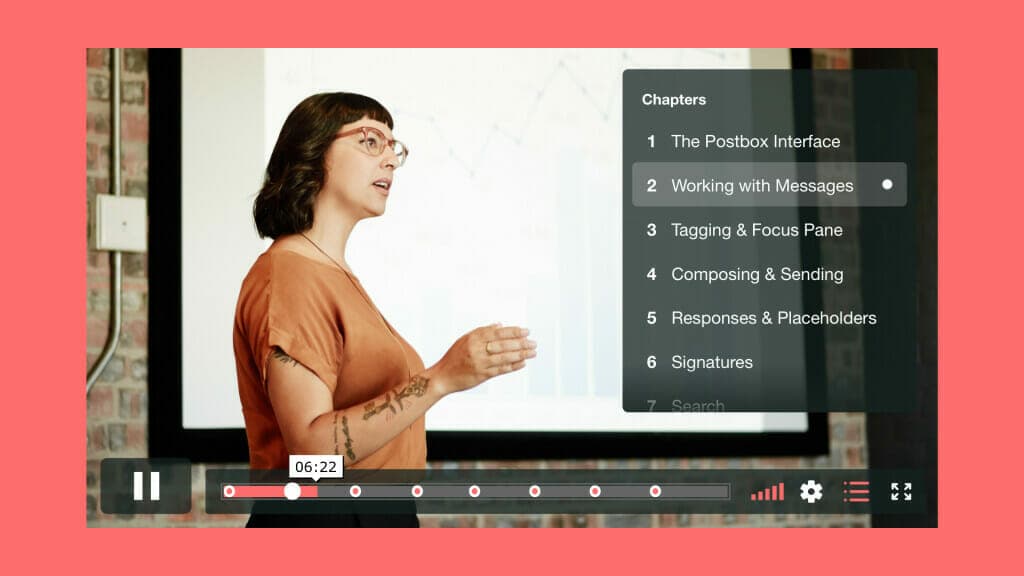
Company Background:
Since its founding in 2004, Vimeo has evolved into one of the most recognized cloud video hosting platforms on the internet. It gained popularity early on for its clean, ad-free experience, making it a favorite among professional creators and brands. Today, Vimeo provides enterprise video hosting and live streaming services tailored to businesses of all sizes.
Vimeo stands out by prioritizing quality over quantity, offering a streamlined user interface, advanced customization options, and a professional-grade environment for video content. Its platform supports both live and on-demand video, with tools for collaboration, branding, and analytics.
As a cloud-based video platform, Vimeo provides simplified live streaming with features like graphic overlays, live chat, and social sharing. Its secure cloud-based video delivery system and detailed privacy controls make it ideal for businesses seeking high-quality and secure content distribution.
Key Features:
- Collaboration and review tools
- Integrations and API access
- Video CMS and library management
- Social distribution
- Monetization options
| Pros | Cons |
|---|---|
|
|
Pricing:
Vimeo offers basic video hosting plans that are suitable for content creators and startups.
Pricing if billed monthly, is as follows:
- Free: $0/month; 1 GB storage, creation and editing, screen recording
- Starter: $20/month; 100 GB storage, auto closed captioning, custom URLs and video player, privacy tools
- Standard: $41/month; 1 TB storage, engagement and social analytics, AI script generator, teleprompter, brand kit
- Advanced: $125/month; 5 TB storage, stream to multiple destinations, host live broadcasts and webinars, AI-generated chapters and text summaries
- Enterprise: Custom pricing; more storage and bandwidth, advanced AI capabilities, quality events, dedicated support
All plans are billed annually.
Vimeo’s OTT solution is priced separately from the regular Vimeo packages. There are two plans: Starter and Enterprise.
- Starter Pricing: $1/subscriber per month
- Enterprise Pricing: Please contact Vimeo for custom pricing information
Best Use Cases:
- Business video hosting
- Online courses and education platforms
- Creative agencies and filmmakers
- Video monetization and OTT channels
- Live events and webinars
- Internal corporate training
- Website video embeds for brands
Cloud Video Hosting Novelties in 2025
| Feature | Description |
|---|---|
| AI‑Assisted Captioning & Search Indexing | Real‑time speech recognition now auto‑generates accurate captions in 40+ languages and indexes spoken phrases for instant search—core to any modern AI‑powered cloud video platform. |
| AI‑Driven Content Insights | Computer vision and NLP detect sentiment, brand mentions, and compliance violations, turning raw footage into actionable data dashboards. |
| Sustainability Metrics | Providers display per‑stream carbon scores and offer routing options that favor renewables, helping enterprises hit ESG targets. |
| Green Cloud Infrastructure | Data centers adopt liquid cooling, dynamic power scaling, and renewable‑energy SLAs to reduce emissions by up to 30 %. |
| 5G + Edge Delivery | Content cached at edge nodes—often within 50 ms of the viewer—paired with 5G last‑mile links, slashes live latency to sub‑2 seconds worldwide. |
| AI‑Powered Transcription, Tagging & Metadata | Multi‑modal AI tags faces, objects, and topics automatically, feeding smarter recommendations and enhancing accessibility. |
| Edge‑Fanout for Low‑Latency Streaming | New WebTransport/WebRTC hybrid pipelines replicate streams across edge PoPs, enabling real‑time interactivity for sports, auctions, and gaming. |
AI Trends in Cloud Hosting
- AI‑Assisted Metadata Tagging: Deep‑learning models now auto‑label scenes, products, and on‑screen text, reducing manual curation time by 80 %.
- Auto‑Transcriptions at Scale: Transformer‑based speech engines deliver < 2 % word‑error rate, making every video instantly searchable and compliant with accessibility laws.
- Adaptive Bitrate with Predictive AI: Next‑gen adaptive bitrate video hosting solutions forecast a viewer’s bandwidth 2‑3 seconds ahead, pre‑selecting the optimal rendition to cut buffering by 35 %.
- AI‑Optimized Encoding: Neural encoders choose the most efficient codec and ladder per title, trimming storage footprints while preserving perceptual quality.
- Dacast AI Roadmap Highlights
- Smart Captioning & Translation (beta): Auto‑generates and localizes captions in 25 languages.
- Viewer Sentiment Analytics (Q3 2025): Surface mood and engagement scores per scene.
- Predictive CDN Routing (pilot): AI routes traffic through the fastest edge based on real‑time telemetry, boosting QoE and reducing transit emissions.
How to Choose the Right Cloud Video Host
First, you need to define your primary use case:
| Use Case | Prioritized Features |
|---|---|
| Education (K–12 / Higher Ed) | LMS integration, lecture capture, mobile-friendly UX, secure cloud-based video delivery, closed captions, student analytics |
| Enterprise (Training / Comms) | SSO, secure video hosting, internal access control, integrations with Slack/Teams/CRM, video CMS platform |
| Faith-Based Organizations | Easy live streaming, mobile access, donations integration, video archiving, and simple embed options |
| Media & Broadcasting | Low-latency live streaming, monetization tools, video hosting platform with CDN support, multi-device delivery |
| Marketing & Sales | Viewer-level analytics, video CTAs, CRM integrations, branded players, and an AI-powered cloud video platform |
| Healthcare / Compliance | HIPAA support, region-based hosting, secure cloud-based video delivery, role-based permissions, and audit logs |
Always consider the emerging need by asking the following questions:
- Do you need AI-powered transcription, tagging, and metadata?
- Are you optimizing for low-latency delivery via 5G and edge nodes?
- Do you want a sustainable video hosting platform?
- Do you need a China-compliant video hosting service?
FAQs
1. What is cloud video hosting, and how does it work?
Cloud video hosting allows you to store, manage, and stream video content via cloud servers. It uses global content delivery networks (CDNs) to ensure reliable access and playback from anywhere.
2. How is cloud video hosting different from self-hosting?
Cloud hosting offloads infrastructure management to a provider, offering scalability, security, and global reach. Self-hosting requires in-house servers, maintenance, and bandwidth handling, making it less efficient and harder to scale.
3. What are the advantages of cloud-based video streaming for enterprises?
Enterprises benefit from scalability, secure access controls, analytics, global distribution via CDN, integration with internal tools, and minimal IT overhead.
4. What features should I look for in a professional cloud video platform?
Key features include secure video delivery, adaptive bitrate streaming, analytics, API access, live/VOD support, LMS and CRM integration, customizable players, and 24/7 support.
5. How does Dacast compare to other cloud video hosting providers?
Dacast offers a feature-rich, cost-effective solution with powerful live streaming, VOD hosting, white-label branding, China delivery, and secure video hosting—ideal for enterprise and professional use.
6. Is cloud video hosting secure for sensitive or internal videos?
Yes, professional platforms offer encryption, access control, password protection, tokenized URLs, and secure CDN delivery to protect sensitive content.
7. How does AI improve video hosting in 2025?
AI enhances hosting with automatic transcription, smart tagging, personalized recommendations, content indexing, adaptive bitrate prediction, and content insights for better viewer engagement.
8. Can cloud video hosting support 4K, VR, or low-latency streaming?
Yes, most modern platforms support 4K resolution, VR content, and sub-second latency streaming through edge computing and optimized protocols.
9. What’s the best cloud video platform for educational institutions?
Platforms like Panopto, Kaltura, and Dacast are great for education, offering LMS integration, secure streaming, mobile access, and lecture capture.
10. What are the pricing models for cloud video hosting platforms?
Common models include subscription plans (monthly/annually), pay-as-you-go, or custom enterprise pricing based on bandwidth, storage, and features.
11. Can I host my business videos on Google Cloud?
Yes, technically, you can use Google Cloud Storage and Transcoder API, but it requires custom development. For easier video management, use platforms like Dacast that integrate cloud infrastructure with turnkey tools.
Conclusion
Cloud video platforms are changing how broadcasters, businesses, and educators connect with their audiences. From hosting video libraries to delivering high-impact live streams, having the right cloud video hosting solution can mean the difference between friction and success.
Dacast is a secure, enterprise-grade cloud video hosting platform trusted by over 300,000 broadcasters worldwide. Whether you’re streaming live events, training internal teams, or launching a global VOD library, Dacast empowers you to scale without limits
Start your FREE 14-day trial today — no credit card required. Experience full access to our professional tools, powerful video CMS, and scalable infrastructure built for serious video delivery.
See how Dacast can help you grow, engage, and monetize with video.
 Stream
Stream Connect
Connect Manage
Manage Measure
Measure Events
Events Business
Business Organizations
Organizations Entertainment and Media
Entertainment and Media API
API Tools
Tools Learning Center
Learning Center Support
Support Support Articles
Support Articles